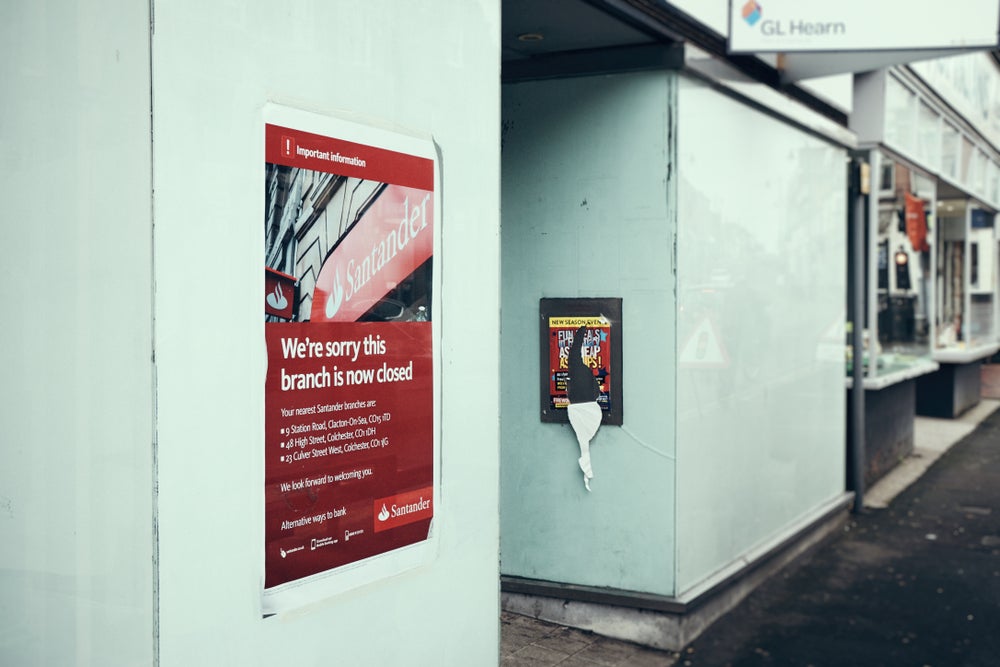The past year has been good for the UK’s
fifth-largest banking group, Lloyds TSB. For years seen as the
weakest of the main UK bank groups, seemingly under near-constant
threat of being bought, it is now enjoying a stronger business
profile as its new seven-year branch revamp programme illustrates.
William Cain reports.
In one of the most ambitious projects of its type in the UK to
date, Lloyds TSB has launched an overhaul of its entire UK branch
network under a seven-year project. The bank, the UK’s
fifth-largest bank by assets, is keeping the full details of the
scheme under wraps until August, when the first branch will be
officially unveiled.
But Allen International, the design consultancy doing the work
on behalf of Lloyds, told RBI the project is already
underway and around 150 outlets should be complete by Christmas. It
will be extended to the rest of the network over the next seven
years.
Neither Allen International nor Lloyds TSB would comment on the
cost of the deal, but a reliable source said it was worth around
£650 million ($1.2 billion). On the wider project, Lloyds TSB said
it was unable to confirm future plans. But Eric Daniels, the bank’s
CEO, in a speech at the British Bankers’ Association (BBA) annual
conference in London on 10 June, talked about the importance of a
strong branch network.
How well do you really know your competitors?
Access the most comprehensive Company Profiles on the market, powered by GlobalData. Save hours of research. Gain competitive edge.

Thank you!
Your download email will arrive shortly
Not ready to buy yet? Download a free sample
We are confident about the unique quality of our Company Profiles. However, we want you to make the most beneficial decision for your business, so we offer a free sample that you can download by submitting the below form
By GlobalData
“There is a renaissance in the branch underway. Customers value
them. The role of a traditional branch will change and retail
banking executives understand that it’s one of the key drivers of
growth.
“There are different ways that banks will deliver growth through
branches. Some will turn to automation and self service to drive
profit. Others will use a more customised approach to better serve
customers and give them advice on products. In either case,
branches will be part of a multi-channel capacity and will be
vital.”
The design for the new-look branches has been agreed and a pilot
stage was completed earlier this year, with a prototype constructed
in a warehouse (the design consultancy would not reveal details of
the new design concept). Michael Allen, chief executive of Allen
International, said that when Terri Dial, Lloyds TSB’s
recently-departed head of retail banking, was showed around the new
concept she said it was the best she had seen. Helen Weir, who
replaced Dial in April, will now be in charge of the project.
As well as Lloyds TSB, Allen International is currently working
with National Bank of Greece, Intesa Sanpaolo and Raiffeisen
International in Europe. Allen said his organisation was also close
to signing a deal with one of the big four banks in Japan.
He added: “Up until now it has been Europe which has been at the
forefront of branch and distribution innovation. But this is a very
positive thing for UK banks going forward.”
The programme comes after a smaller Lloyds TSB internal branch
programme which saw new branch formats tried out on a smaller scale
in different cities across the UK. That included three revamped
branches in London and others in major towns such as Hull and
Sheffield. Lloyds TSB has the second-largest number of branches in
the UK, with around 1,950, compared to Royal Bank of Scotland’s
2,278, according to a recent RBI survey (see above,
and RBI 584).
The UK’s most conservative bank
The branch project is significant for Lloyds TSB not least
because it has been perceived as one of the UK’s most conservative
banks. Allen International, based in London, has worked with some
of the most innovative European banks on how to get the best out of
their outlets, including a recent project with Austria’s Erste Bank
(see image above). But UK banks have lagged way behind
their continental rivals.
Allen added: “The UK banks’ approach to branch design is
dreadful. Other countries are way ahead, but hopefully this will be
the start of something new.”
But Lloyds TSB has emerged as one of the stronger UK banks in
the wake of the global credit crunch. Increasingly, it looks like
the bank’s conservative business strategy is being vindicated,
while the repositioning of its brand is seeing it become one of the
country’s most engaged consumer banking groups.
The ambitious branch project, along with the news it had signed
a deal to cherry-pick the best mortgage customers from
publicly-owned Northern Rock, are the latest in a string of
high-profile coups for the bank.
 In 2007, its retail banking
In 2007, its retail banking
division registered a 12 percent increase in pre-tax profits – the
highest in its peer group – to £1.73 billion. That figure increased
to 17 percent excluding provisions for the settlement of overdraft
claims (see RBI 591).
Total income increased by £317 million, or 6 percent, supported
by higher income from current accounts, savings and personal
lending. Overall sales increased by 17 percent, with improvements
especially in current accounts, credit cards and bank savings
products. Sales volumes were particularly strong in the branch
network, stated Lloyds TSB, up 24 percent.
The bank said it attracted over one million new current accounts
in 2007 and, according to its own figures, became the number one
provider of current accounts, cards and personal loans in the UK.
Customer deposits increased strongly, by 8 percent, with
particularly strong progress in growing bank savings and wealth
management deposit balances, with increases of 15 percent and 12
percent, respectively.
Much of the credit for that performance goes to Dial, the bank’s
outgoing head of retail banking. The Californian has helped refresh
the bank’s image on the high street, bringing a US approach to
British banking which is increasingly differentiating Lloyds TSB
from its rivals. As well as playing a role in the new branch
strategy, Dial was instrumental in bringing new products to the
market.
One of the bank’s biggest product launches, for instance, has
been its Save the Change programme, borrowed from Bank of America’s
Keep the Change. The accounts help customers save by rounding up to
the nearest whole pound or dollar every purchase made with a debit
card. The difference is then transferred to a savings account –
Bank of America’s product recently topped $1 billion in deposits
(see RBI 592).
A significant shift in strategy
But while Dial does leave the bank in good health relative to
its UK rivals, unlike the rest of the top five it does not have a
retail banking franchise outside of its domestic market. There has
been some speculation linking Lloyds TSB with a move for other UK
banks such as Bradford & Bingley or Alliance and Leicester.
 But, at the BBA conference in
But, at the BBA conference in
June, chief executive Daniels hinted at something which would mark
an even more significant shift in strategy for the bank: a move
into Europe’s emerging markets. The bank has also been recently
linked with a move for Germany’s largest retail banking player,
Deutsche Postbank.
In his speech at the event, Daniels said: “I believe
cross-border consolidation will continue as banks look for
inorganic growth. Improvements in relations between European states
will make this easier and some players will be opportunistic
because of the current market problems.
“But we should not get too carried away, because while many
commentators have predicted big changes, it has not been quite as
easy as that. Cross-border synergies are notoriously hard to
achieve.”
Daniels said the retail banking market was hugely competitive
and customers had benefitted from lower cost products and increased
product choice. But he said dislocations in the market meant there
was a lower opportunity for shareholder returns in the future.
“Strategies of institutions will be critical in terms of
success. We are clearly in a time of uncertainty and stakeholder
reactions will in part determine the base at which we can continue
to create value. Those who are most likely to create value are
those that can access liquidity effectively, deliver outstanding
service to customers, manage distribution effectively and manage
and scale operations effectively.
“Essentially those that focus on the basics of retail banking
will be the winners. Finally, if the current situation holds, for
those retail banks that understand their customers and know how to
read markets, then new opportunities for growth will be
created.”
In addition to the importance of branch networks and intensified
cross-border consolidation, Daniels said there were three other key
challenges facing the UK industry: the pricing and availability of
long-term liquidity, regulation, and the evolution of monolines.
Low levels of liquidity are reducing levels of supply and demand
for credit. Daniels said that even when higher levels of liquidity
returned to the market, it was unlikely the gap between Libor and
base rates would fall to their previous levels.
He said: “Consumers are pulling back and not growing their
personal balance sheets as they have.”
A consumerist agenda
On regulation, Daniels said there was an increasing shift from a
consumerist agenda to one which focused on the functioning of the
financial system itself. But he said UK banks enjoyed a relatively
benign regulatory regime and were in a strong position to compete
in Europe.
Monoline businesses, Daniels added, could help build product
expertise and traditional banks have sometimes used them to enter
new markets to expand their expertise. But he said the threat to
banks from mono-liners was undermined because of the limited
opportunity they have to obtain funding. Although there was a role
for them, full service banks would retain a competitive advantage
because they had the ability to package together and sell different
products through multiple channels, he said.
“We are potentially entering a period of change which could
result in major shifts in the market. And the reactions of markets,
regulators and customers will in some part dictate future patterns
in value creation.”
But he issued a caveat that predicting the future of retail
banking was only slightly less risky than playing the lottery to
fund your retirement.







